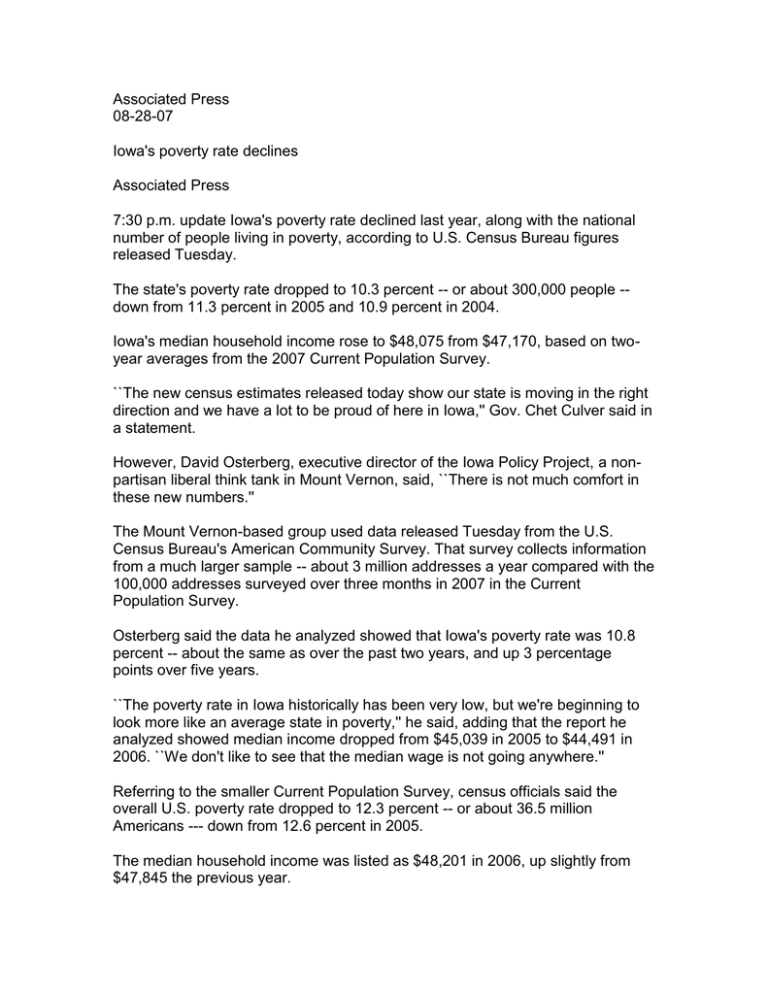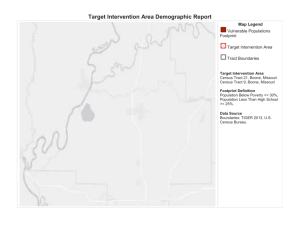Associated Press 08-28-07 Iowa's poverty rate declines
advertisement

Associated Press 08-28-07 Iowa's poverty rate declines Associated Press 7:30 p.m. update Iowa's poverty rate declined last year, along with the national number of people living in poverty, according to U.S. Census Bureau figures released Tuesday. The state's poverty rate dropped to 10.3 percent -- or about 300,000 people -down from 11.3 percent in 2005 and 10.9 percent in 2004. Iowa's median household income rose to $48,075 from $47,170, based on twoyear averages from the 2007 Current Population Survey. ``The new census estimates released today show our state is moving in the right direction and we have a lot to be proud of here in Iowa,'' Gov. Chet Culver said in a statement. However, David Osterberg, executive director of the Iowa Policy Project, a nonpartisan liberal think tank in Mount Vernon, said, ``There is not much comfort in these new numbers.'' The Mount Vernon-based group used data released Tuesday from the U.S. Census Bureau's American Community Survey. That survey collects information from a much larger sample -- about 3 million addresses a year compared with the 100,000 addresses surveyed over three months in 2007 in the Current Population Survey. Osterberg said the data he analyzed showed that Iowa's poverty rate was 10.8 percent -- about the same as over the past two years, and up 3 percentage points over five years. ``The poverty rate in Iowa historically has been very low, but we're beginning to look more like an average state in poverty,'' he said, adding that the report he analyzed showed median income dropped from $45,039 in 2005 to $44,491 in 2006. ``We don't like to see that the median wage is not going anywhere.'' Referring to the smaller Current Population Survey, census officials said the overall U.S. poverty rate dropped to 12.3 percent -- or about 36.5 million Americans --- down from 12.6 percent in 2005. The median household income was listed as $48,201 in 2006, up slightly from $47,845 the previous year. But, some experts said, the increase appeared to be driven by a jump in the number of people in each household taking on full-time jobs, rather than a rise in wages. The poverty level is the official measure used to decide eligibility for federal health, housing, nutrition and child-care benefits. It differs by family size and makeup. For example, for a family of four with two children, the poverty level is $20,444. The poverty rate -- the percentage of people living below poverty-- helps shape the debate on the health of the nation's economy. The figures show the first decline in the poverty rate since President Bush took office. The numbers represent economic conditions from a year ago. ``It's sort of what you'd expect from continued economic expansion,'' said Iowa State University economist Peter Orazem. ``It tends, at least eventually, to benefit people at the lower tail of the distribution.'' The number of people in the United States without health insurance increased to 15.8 percent, or 47 million, up from 15.3 percent the previous year. According to a three-year average, Iowa's rate was about 9.3 percent, or 271,000 people. Osterberg said the survey he analyzed showed that 10.5 percent of Iowans, or about 307,000, were uninsured. The poverty rates released by the U.S. Census Bureau are not an accurate measure, Orazem said, adding they are based on a 1955 data set that's been allowed to increase with inflation. ``And, I think most people who were wanting to measure poverty would not say, `OK, that's how we would start measuring poverty if we were to start anew,'‚'' he said.





